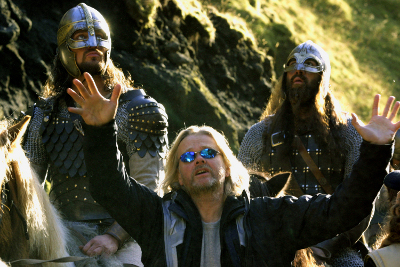Sturla Gunnarsson Screens Beowulf and Grendel at the University of Victoria
Margaret and Richard Beck Lectures
University of Victoria
January 14, 2010
Article by Jasmine Johnston

Icelandic-Canadian film director Sturla Gunnarsson visited the University of Victoria as a Beck Fund lecturer on January 14 and 15, 2010.
On Thursday evening, Sturla screened his film Beowulf and Grendel at the university cinema, followed by a question and answer period.
There were numerous questions for the director. He addressed a variety of topics, including writing the script, historicization of the poem, casting, character development, set and costume design, the landscape of Iceland, and his own experiences of Iceland.
When asked about the script, Sturla told the story of collaborating with Andrew Berzins. They had worked well together on a previous project, and so met again to discuss possible future projects. After covering many options, they looked at one another and asked what they really wanted to do. Berzins said he had always wanted to write a film version of Beowulf. Sturla replied that he had always wanted to make a film in Iceland.
Together Berzins and Sturla created a story which took Beowulf back to its postulated pagan roots, conceiving a world where monsters were actually competing humanoid species such as Homo sapiens neanderthalensis or Homo gigantus. Much of their inspiration for Grendel was drawn from legends and stories of the Sasquatch. Sturla stated that they tried to reconstruct, in creative but realistic ways, how the historicized events of their script would become campfire tales, and then legend.
Sturla then answered questions about Gerald Butler, Ingvar Eggert Sigurðsson, and Sarah Polley. The process of casting Butler was in part a matter of hitting it off, which in turn, Sturla stated, contributed to the successful financing of the project, a matter of international cooperation between Canada, Iceland, and the UK.
Ingvar, a well-known actor in Iceland, contributed a great deal to the development of Grendel’s look and behaviour, working with prosthetic designers to generate distinctive movements and features. In the end, said Sturla, Grendel’s look was quite natural, with only a few prosthetic enhancements, none of them computer-generated.
Sarah Polley’s role as the pagan witch Selma served to anchor the film in a pagan worldview, as well as emphasize and examine the nature of kinship.
Set and costume design were based on one key concept: gems in the mud.
All the costumes follow a palate drawn from the landscape, and while realistic in their practicality and making, are also specific to creative conceptions of each character. The earthy colours are in counterpoint with flashes of finery in ornaments and weaponry. The Geatish court, Sturla stated, is intended to be more formal, while the Danish tribe is intended to look rough.
A member of the audience asked Sturla what Iceland means to him. He replied that it was the place he was born and lived in until the age of seven, the place where he learned his first language, Icelandic, and the place he first dreamed. He stated that images of Iceland’s landscape stayed with him, which is why he wanted to return to that landscape through the filming of Beowulf and Grendel.
The tone of the audience was enthusiastic and engaged; not only were students, faculty, and community members in attendance, but also a large first-year English literature class, comprised of undergraduate students from many disciplines. Their questions were diverse, ranging from issues of historical research to film festivals, from pagan practices to sea hag caves. At a question from one student the audience learned that the long poles lifted up around the great hall Heorot are cow-scares,
a concept created by the set designers, where cows’ heads are put on poles to scare off enemies.
The film screening and question and answer period concluded with an enthusiastic round of applause for Sturla, and several members of the audience gathered around afterwards for further questions and conversation.
The Beck Lectures are coordinated by Dr. John Tucker and Dr. W. D. Valgardson, and Trish Baer, a PhD in Icelandic studies at the University of Victoria. For more information, visit the Beck website.